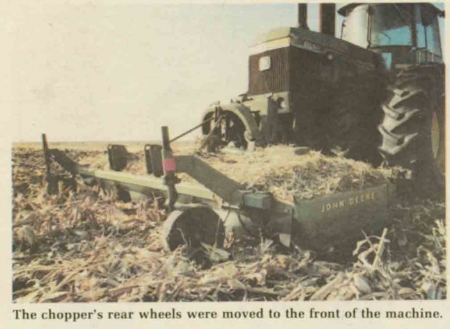
Iowa farmers Ray and Roger Hade, of Harcourt, reduced the number of trips their tractor makes across fields by mounting a stalk chopper on the front of their tractor, leaving room behind for a "ripper" subsoiler, an anhydrous tank and a liquid fertilizer tank.
Ray's son, Roger, explains how the conversion (a 1408 Deere rotary stalk chopper mounted on the front of a Deere 8640 tractor) was made:
"First, we put a sprocket on the PTO shaft and extended the shaft past the sprocket for powering a centrifugal pump that injects anhydrous and liquid fertilizer.
"Two double 60 chains connect the sprocket on the PTO shaft with another sprocket that sits about a foot under it and connects to a PTO shaft that runs to the front of the tractor. The shaft under the tractor hangs on 4 hanger bearings and, since the tractor is articulated, the shaft is knuckled twice.
"The chopper is the same as before except, instead of pulling it, we're pushing it. We took the wheels off the back of the chopper and put them up front, and we added some braces for lifting the chopper. We also mounted two, 8-in. hydraulic rams on the front of the tractor for lifting and lowering the chopper. The hydraulics for the ram comes from the back of the tractor and is split so we can operate the chopper independently of the ripper.
"All we had to do gearwise was to turn the gear box around on the chopper. The nice thing about the chopper conversion is that it's real easy to convert the chopper back to pull type.
"The only real problem we've had with the chopper conversion is with the chain connecting the sprockets on the PTO. Stalks get in there and cause problems. We plan to solve the problem by enclosing the chain and sprockets in an oil bath."
The chopper and the ripper both cover six, 30-in. rows. Originally, the ripper had 11 knives but Roger cut it down to 6 and mounted a hitch on each side of the ripper (one for the anhydrous tank and the other for the liquid fertilizer tank).
When FARM SHOW visited the Hade farm the tanks weren't being pulled on account of frozen ground.
